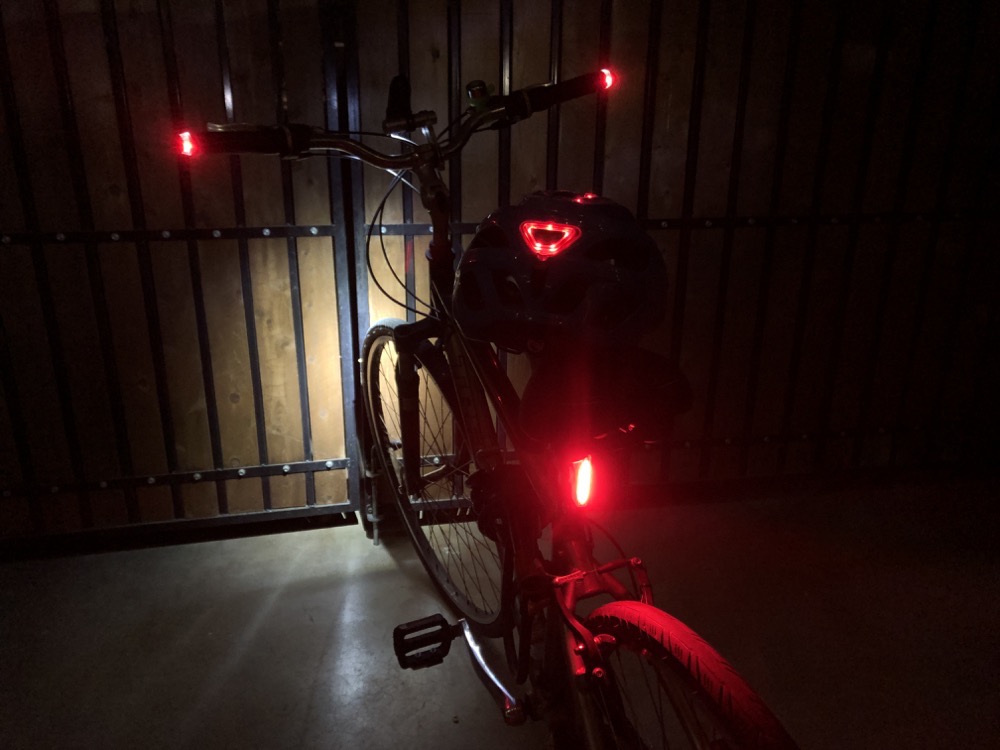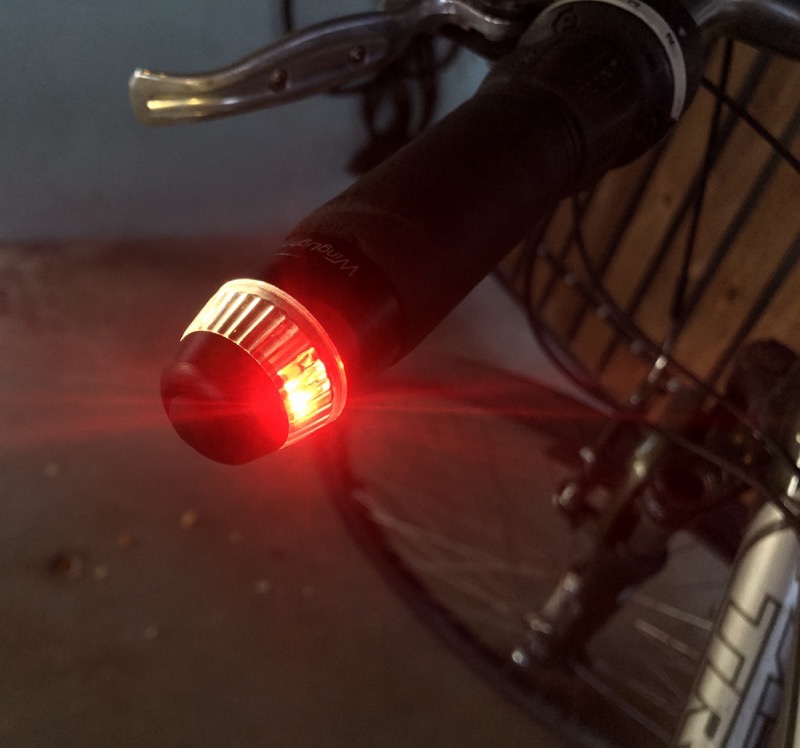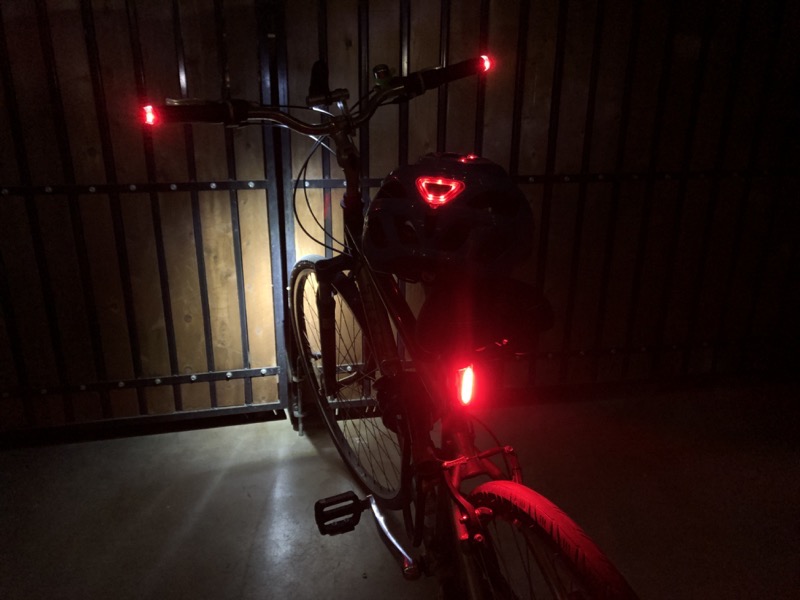 Hey, this is Joe Dugandzic from Smarter Home Life, and normally I talk all about home automation and how you can make your home a bit “smarter”, or something like that. And, I’m always talking about how lighting plays a big role in our lives, especially at home. But for someone who puts a lot of miles on his bike each month, specifically a 2012 Trek model 7100, I always want to be sure that I’m visible to other people, cyclists and, of course, motor vehicles when I’m out riding.
Hey, this is Joe Dugandzic from Smarter Home Life, and normally I talk all about home automation and how you can make your home a bit “smarter”, or something like that. And, I’m always talking about how lighting plays a big role in our lives, especially at home. But for someone who puts a lot of miles on his bike each month, specifically a 2012 Trek model 7100, I always want to be sure that I’m visible to other people, cyclists and, of course, motor vehicles when I’m out riding.
Bicycle visibility is especially important, of course, at night. Most cities have ordinances that require the use of at least a white headlight and a red rear reflector. But even for those of us who have a ludicrously bright headlight and tail light, both of mine are also USB rechargeable I might add—see the episode notes for product links—bicycle lights tend to light up the road but not necessarily you or your bike. And visibility at night is especially important when looking at a bike from the side, because the thin profile of a bicycle is pretty hard to illuminate.
Some companies have tried to tackle this, usually by just selling kits that add little LEDs to the spokes of the wheels, which make for fun lighting effects when you’re in motion, but they’re kind of silly in my opinion. Earlier this decade, a crowdfunded company based out of San Francisco called Revolights took the cycling world by storm with their specialized wheel lights that acted as a headlight and a taillight, and they formed an arc of light on the outside of the rim of each side of the wheel when a bike was in motion.
Revolights eventually launched versions that had smartphone app control, blinked the taillight upon braking, and promised turn signals that would blink each side of the taillight. But alas, their product was priced at $150 and up, was challenging to install…and as of January of this year, they sadly closed their doors.
Since it seems that I’m usually on a budget, I really liked the Revolights concept, but I just couldn’t quite take the plunge for such an expensive product, which would have had some other drawbacks for my own bike once installed, that I don’t have time to go into.
So, I started looking for another, less complicated and less expensive solution. At first I just mounted some color-changing—and of course, remote-controllable—LED tape light on the underside of the down tube on my bike and hooked it up to a USB power bank. It did light up a bit of the bike, and more of the road, but was a bit much even at its dimmest setting, and I didn’t really need to stand out that much when riding at night. After a few months, the Phoenix heat and road debris wore away some of the LED tape and wiring and it just didn’t work at all anymore.
So I abandoned trying to light up my bike’s structure or wheels, and went back to an idea from Revolights that I had really liked: Turn Signals. I personally have never really used hand signals when cycling, partly because I think they look silly and I can’t remember which one means what (I know, I know, it’s pretty dumb for a cyclist to not understand hand signals).
But I think that most drivers don’t understand, or even recognize them either. Cars, trucks and motorcycles…all of those vehicles are equipped with onboard, bright, blinking turn signals (or perhaps a more nerdy definition – directional indicator illuminators). So why is it that cyclists are left with dumb, old-fashioned, manual hand signals? Because that’s just the way it has always been done and evidently no one came up with a better solution.
Well, as it turns out, a number of years ago, a few enterprising folks in the UK set out to improve safety and visibility for cyclists. And thus, a company called Cycl (c-y-c-l) and their product called WingLights were born. I’m not even quite sure how I ran into their product, but somehow I landed on it by searching for bike turn signals or something like that.
 WingLights in their simplest form are beautifully-designed, very bright amber LED “blinker lights” that mount to the ends of straight or slightly curved bicycle handlebars. They are roughly the same diameter as your handlebars and make for a very sleek, integrated look with your bike. This was something that I instantly loved about the concept of WingLights. Once installed, they look like they have always been a part of your bike, and not some silly gadget made by Janksicle Industries that you had to hack onto your bike.
WingLights in their simplest form are beautifully-designed, very bright amber LED “blinker lights” that mount to the ends of straight or slightly curved bicycle handlebars. They are roughly the same diameter as your handlebars and make for a very sleek, integrated look with your bike. This was something that I instantly loved about the concept of WingLights. Once installed, they look like they have always been a part of your bike, and not some silly gadget made by Janksicle Industries that you had to hack onto your bike.
Oh, so speaking of being integrated, WingLights only extends your handlebars by about an inch to maybe an inch and a half on each end, depending on the version that you get. And they weigh as little as just 58 grams, depending on the model. So while I’m talking about specs…just how bright is bright? Well the least-bright of all the WingLights is rated at 48 lumens per indicator and the brightest is 64 lumens per indicator.
And let’s be realistic, from a distance during the day, someone may see your blinker out of the corner of their eye but remember that these guys are still pretty small. You’re a bike, not a car or truck with full-size power source. At night, however, they are very, very visible and will get people’s attention. I personally prefer the WingLights that where the LEDs are not under frosted cover because the individual LED elements are more attention grabbing in my humble opinion than a frosted end cap. But adding any WingLights to your bike is still a great upgrade.
There are two general versions of the WingLights products, one that stays attached to the handlebars and one that screws onto the handlebar mounts and stays locked on with very strong magnets. Both versions use a patented mounting system that inserts into the ends of handlebars that have an inner diameter of 14.9 to 22mm. I should also mention that all of the WingLights devices are fully weatherproof, but not necessarily completely life-proof. Once mounted to your bike, they stay securely attached, sometimes to their detriment as the anodized aluminum finish can get scuffed up pretty easily. I personally have the magnetic ones, because people seem to like to take stuff off my bike when it is locked up, and as I do take the bike on our local trains for getting around, removing them prevents the WingLights from getting knocked around or accidentally activated.
Speaking of activation, WingLights sadly do not yet feature a neural link that can understand when you want to make a turn or have some kind of fancy tilt sensors onboard. But there is a dedicated button on the end of each WingLight that can be pushed to activate the flashing LEDs. And they flash with the cadence that you would expect from a turn signal. The button itself has a really good feel to it, too…just press once to turn on, and again to turn off.
More recent WingLights models will shut off the flashers automatically after about a minute if you forget. The least expensive version, called WingLights Pop, costs just $25 a pair, and the “button” is the frosted round “end cap” itself that covers the amber LEDs. The other versions of WingLights have more of a “ring” of light that around the circumference of the device, situated between both ends.
So which version do I have? Well I got my first pair of WingLights Mag in October of 2018, and I was very, very pleased with them right from the start. They are very easy to install with the special rubberized-friction mounts, and I loved being able to take them off the bike to prevent theft and keep them looking in perfect condition. Now, if your bike happens to accidentally land directly on one of the ends of your handlebars, it’s not necessarily the end of your WingLights.
My bike, generally due to no fault of my own, sadly took a number of spills—not while in motion—during the months after I got my WingLights, and they got a bit scuffed up, a bit bent because the mounts stay so securely in the handlebars (I did manage to bend them back somewhat), and one of the buttons became more difficult to activate after it was beat up a bit. But overall, the lights did still continue to work as expected.
Now let’s fast-forward a bit. I really love my WingLights, and they definitely help in letting others on the road know where I’m heading next. But, getting back to the purposes of this piece, and how best to light yourself and your bike up at night…the WingLights only solved part of my problem. So until relatively recently, I was actually planning on designing a custom-built, 3D-printed set of integrated LED downlights that I would mount at the front and back of my bike to illuminate more of the bike’s structure, and the road.
This was going to be a relatively complicated project for a 3D-printing and custom-electronics newbie…and one that I might still take on. But for the moment, it has been shelved. And now, as Paul Harvey used to say on the radio, here is the rest of the story.
Last month, I decided to bring some of my concerns about the durability of WingLights to the company who makes them, CYCL…and of course I also posted it to Amazon, where I originally bought them. CYCL got back to me within about a day and was genuinely sorry to hear about my troubles with their product. They offered me a free set of handlebar mounts to replace mine that I had mostly, well kinda, bent back to normal again. Or, they said they could offer me a discount on buying a whole new set of WingLights.
And this prompted me to peruse their website, which I hadn’t looked at since last fall. I immediately noticed that there were two new products: WingLights 360 Mag and WingLights 360 Fixed. Both with clear “light rings” instead of amber “light rings”, and seemingly different types of LEDs inside. As I read further down the page, I started hearing my wallet calling for me to come grab it and give my credit card some exercise.
The WingLights 360 products come in both a magnetic and fixed version, and feature the same beautiful design that has become integrated into my bike, and of course, their very-bright, amber LED turn signals. The “360” addition to the product are two 10-lumen LEDs for each WingLight…white for the front and red for the rear. While they are not a standard headlight or taillight in brightness, they give others on the road a better sense of how to safely pass you as they indicate the width of your bike. And, the red LEDs will illuminate you to a certain extent, giving you better visibility from the side. Around sunset, the WingLights 360 can be a super-simple way to provide illumination of your bike to others on the road if you are running late when heading back home and you didn’t think you’d need your regular lights that day—which seems to happen to me all the time lately.
 WingLights 360’s new LEDs will illuminate continuously if you long-press, or is it force-touch…oh, right, if you press and hold their buttons for a few seconds, and they will illuminate for up to 3 hours on a single charge, with the blinkers lasting for much, much longer. And, single charge, you ask? Yes, WingLights 360 are USB rechargeable! Nope, sorry, not USB-C. But hey, they will charge in 30 minutes or less! The older WingLights products use two CR2032 coin-cell batteries that will last for about 6 months when used daily, and I can attest to that battery life being pretty darn accurate! You can also evidently get LIR2032 rechargeable lithium batteries for your WingLights and other gadgets, but I have no clue how to charge them. (But, I’m sure there’s probably a solution on Amazon for $6.99 from Janksicle Industries.)
WingLights 360’s new LEDs will illuminate continuously if you long-press, or is it force-touch…oh, right, if you press and hold their buttons for a few seconds, and they will illuminate for up to 3 hours on a single charge, with the blinkers lasting for much, much longer. And, single charge, you ask? Yes, WingLights 360 are USB rechargeable! Nope, sorry, not USB-C. But hey, they will charge in 30 minutes or less! The older WingLights products use two CR2032 coin-cell batteries that will last for about 6 months when used daily, and I can attest to that battery life being pretty darn accurate! You can also evidently get LIR2032 rechargeable lithium batteries for your WingLights and other gadgets, but I have no clue how to charge them. (But, I’m sure there’s probably a solution on Amazon for $6.99 from Janksicle Industries.)
I’ve had my new WingLights 360 Mag combination bike blinkers and “marker lights” for just over a month now, and I love them even more than the WingLights Mag that I used for about 6 months. I am always looking for a chance to ride at night to be able to use them for their full capabilities. And sure, it’s fun to show them off, too.
I could go on and on about WingLights, but this segment is way over the time limit and Allison is waving at me furiously from South America to wrap it up. While I can’t cite any statistics or anything in regards to how many collisions that WingLights have helped me avoid, I’m sure that there have probably been more than a few surprised drivers, pedestrians and other cyclists out there when they see my “bike blinkers” in action, and now especially at night with the red and white “marker lights”.
Cycl officially says that you should continue to use hand signals and that their “turn signal products” should be only be used in addition to them. I say to hell with it all, and that bikes should come with built-in, high-quality lighting systems just like other vehicles on the road. With today’s LED lighting and battery technologies, it’s really no longer a matter of cost or complexity…it should be a standard safety feature. Let’s make hand signals for cyclists go the way of the horse and buggy!
As for the rest of my bike lighting gear, I have a 500-lumen Cycle Torch headlight, a Blitzu 168T crazy-bright tail light, and a Rouler helmet with a integrated rear LED light. At this point, I’m pretty hard to miss out on the road, but not obnoxiously hard to miss. And as I tend to put between 200 and 300 miles on my bike per month, I now have plenty of things to recharge!
Finally—and not related to lighting, but definitely related to safety—for listening to “workout” music while riding, I use bone-conduction Trekz Titanium headphones from Aftershokz which have pretty amazing sound quality for what they are, and I can still hear the environment around my bike. Plus, they’re Bluetooth-equipped, have pause/next track buttons, volume control, an on-board mic so I can even take phone calls…and I can sometimes get Siri to switch playlists.
CYCL is working on additional mounts for other types of handlebars, including drop, bullhorn and cruise, so that every bike can have a pair of WingLights onboard. WingLights start at just $25 for the Pop and go all the way up to $80 for the 360 Mag. Whichever version you decide to get, they are totally worth the price. Check the show notes for this episode for product links.
- WingLights search on Amazon: https://amzn.to/2FlYnIl
- Aftershokz Headphones: https://amzn.to/2IW7noC
- Cycle Torch Headlight: https://amzn.to/2WRL3Bu
- Blitzu Tail Light: https://amzn.to/2FfVtFd
- CYCL Official website: https://cycl.bike

